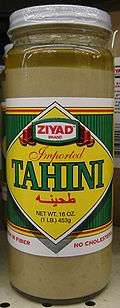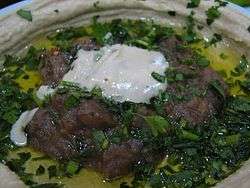Tahini
|
Tahini with lemon and garlic | |
| Alternative names | Ardeh |
|---|---|
| Type | Spread or dip |
| Region or state | Armenia, Bulgaria, Cyprus, Greece, Iran, Jordan, Kurdistan, Iraq, Israel, Lebanon, Levant, North Africa, Palestine, Syria, Horn of Africa, and Turkey |
| Main ingredients | Sesame seeds |
|
| |
Tahini /tɑː.ˈhiː.ni/ (also tahina /tɑː.ˈhiː.nə/ or /tɑː.ˈxiː.nə/; Arabic: طحينة), also known as Ardeh (Persian: ارده), is a condiment made from toasted ground hulled sesame seeds. Tahini is served as a dip on its own or as a major component of hummus, baba ghanoush, and halva. Tahini is used in the cuisines of the eastern Mediterranean region, from the Balkans, Caucasus and Middle East to Northern Africa. It is also widely used in Chinese and South East Asian cuisine, notably Vietnamese cuisine.
Etymology
Arabic
Tahini is a loanword from Arabic: طحينة [tˤaħiːna], or more accurately ṭaḥīniyya طحينية, is derived from the root ط ح ن Ṭ-Ḥ-N which as a verb طحن ṭaḥana means "to grind",[1] the same root as طحين [tˤaħiːn], "flour" in some dialects.
The standard Arabic spelling طحينة is transliterated properly as ṭaḥīnah. The last syllable is pronounced [næ, na, nɑ, ne, nɐ], depending on dialect; in Levantine Arabic dialects, as [ne]. Since most 19th and early 20th century Middle Eastern immigrants to English-speaking countries were Christians from Syria, this may be the origin of the English usage of the final /i/.
English
The word "tahini" appeared in English by the late 1930s.[2][3]
Plain, unprocessed sesame paste with no added ingredients is sometimes known as raw tahini.[4]
Persian
In Persian speaking countries such as Iran and Tajikistan it is known as Ardeh. There is a famous halwa made in Iran called Halwa Ardeh and Ardeh Shireh. Its origins are from Middle Persian.
History
The oldest mention of sesame is in a cuneiform document written 4,000 years ago that describes the custom of serving the gods sesame wine. The historian Herodotus writes about the cultivation of sesame 3,500 years ago in the region of the Tigris and Euphrates rivers in Ancient Iraq. It was mainly used as a source of oil.[5]
Tahini is mentioned as an ingredient of hummus kasa, a recipe transcribed in an anonymous 13th-century Arabic cookbook, Kitab Wasf al-Atima al-Mutada.[6] Sesame paste is an ingredient in some Chinese, Korean, and Japanese dishes; it is used in some versions of the Szechuan dish Dan dan noodles. Sesame paste is also used in Indian cuisine.[7] In the United States, sesame tahini, along with other raw nut butters, was available by 1940 in health food stores.[2]
Preparation and storage
Tahini is made from sesame seeds that are soaked in water and then crushed to separate the bran from the kernels. The crushed seeds are soaked in salt water, causing the bran to sink. The floating kernels are skimmed off the surface, toasted, and ground to produce an oily paste.[8]
Because of tahini's high oil content, many manufacturers recommend refrigeration to prevent spoilage. This is particularly true among makers of raw, organic tahini, who will often prepare their tahini at low temperatures and ship and store it in refrigerated cases to maximize quality and shelf life.[9]
Culinary uses
Tahini-based sauces are common in Middle Eastern restaurants as a side dish or as a garnish, usually including lemon juice, salt and garlic, and thinned with water, as Hummus made of cooked, mashed chickpeas blended with tahini, olive oil, lemon juice, salt and garlic. Tahini sauce is also a popular topping for meat and vegetables in Middle Eastern cuisine.
In Armenia, tahini can be used as a sauce to put in the lahmajoun.
In Turkey, tahini (Turkish: tahin) is mixed with pekmez to form a dish called tahin-pekmez. Due to its high-caloric nature, it is served as a breakfast item or after meals as a dessert to dip pieces of bread in, especially during the wintertime.
In Iraq, tahini is known as "rashi" and is mixed with date syrup (rub) to make a sweet dessert usually eaten with bread.
Tahini is called ardeh (ارده) in Persian and harda in Kuwait. In Iran it is used to make halvardeh (حلواارده), a kind of halva made of tahini, sugar, egg whites, and other ingredients. It is also eaten during breakfast, usually with an accompanying sweet substance, usually grape syrup, date syrup, honey, jams, etc. Ardeh and halvardeh are among the souvenirs of the Iranian cities of Yazd and Ardakan.
In Cyprus, tahini, locally known as tashi, is used as a dip for bread and in pitta souvlaki rather than tzatziki, which is customary in Greece.
In Greece, tahini (Greek: ταχίνι) is used as a spread on bread either alone or topped with honey or jam. Jars of tahini ready-mixed with honey or cocoa are available in the breakfast food aisles of Greek supermarkets.
In Israel, tahini (Hebrew: טחינה t'hina) is a staple foodstuff. It is served as a dip with flat bread or pita, a topping for many foods such as falafel, sabich, Jerusalem mixed grill and shwarma, and as an ingredient in various spreads. It is also used as a cooking sauce for meat and fish,[10] and in sweet desserts like halva, halva parfait,[11] halva ice cream and tahini cookies. It is also served baked in the oven with kufta made of lamb or beef with spices and herbs, or with a whole fish in the coastal areas and the Sea of Galilee.
In the Gaza Strip, a rust colored variety known as "red tahina" is served in addition to ordinary tahina. It is achieved by a different and lengthier process of roasting the sesame seeds, and has a more intense taste. Red tahina is used in sumagiyya (lamb with chard and sumac) and salads native to the falaheen from the surrounding villages, as well as southern Gaza.
In the Levant, tahini (Levantine Arabic: t'hine) is a staple foodstuff prepared with mashed garlic and lemon juice. It is served as a dip with pita, a topping for falafel and shwarma, and as an ingredient in various spreads. It is also used as a cooking sauce for meat and always served as a side with fish. It is also a main ingredient in a seafood dish called Siyadiyeh. Tahini is in sweet desserts like halva and halva with pistachios.
In East Asia, sesame paste (Chinese: 芝麻醬) is a major condiment used in dry noodles (hot or cold). Sesame paste can also be eaten as a snack, known as black sesame soup.
Nutritional information
| Tahini nutrition facts |
|---|
| Nutritional value per 100 g (3.5 oz) | |
|---|---|
| Energy | 2,489 kJ (595 kcal) |
|
3 g | |
|
53.76 g | |
|
17.00 g | |
| Vitamins | |
| Vitamin A | 67 IU |
| Thiamine (B1) |
(106%) 1.220 mg |
| Riboflavin (B2) |
(39%) 0.473 mg |
| Niacin (B3) |
(36%) 5.450 mg |
| Pantothenic acid (B5) |
(14%) 0.693 mg |
| Vitamin B6 |
(11%) 0.149 mg |
| Folate (B9) |
(25%) 98 μg |
| Vitamin B12 |
(0%) 0.00 μg |
| Minerals | |
| Calcium |
(43%) 426 mg |
| Iron |
(69%) 8.95 mg |
| Magnesium |
(27%) 95 mg |
| Manganese |
(69%) 1.456 mg |
| Phosphorus |
(105%) 732 mg |
| Potassium |
(9%) 414 mg |
| Sodium |
(8%) 115 mg |
| Zinc |
(49%) 4.62 mg |
| Other constituents | |
| Water | 3.05 g |
| |
| Percentages are roughly approximated using US recommendations for adults. | |
Tahini is an excellent source of calcium, manganese and the amino acid methionine.[12] Tahini is a source of healthy omega-3 and omega-6 fatty acids.[13]

Tahini made from raw sesame seeds is lower in fat than tahini made from roasted seeds.[14][15]
Tahini's relatively high levels of calcium and protein make it a useful addition to vegetarian and vegan diets, as well as to raw food diets when eaten in its unroasted form. Compared to peanut butter, tahini has higher levels of fiber and calcium and lower levels of sugar and saturated fats.[16]
| Look up tahini in Wiktionary, the free dictionary. |
See also
- List of dips
- List of sesame seed dishes
- List of spreads
-
 Food portal
Food portal
References
- ↑ Ghillie Basan, Jonathan Basan (2006), The Middle Eastern Kitchen: A Book of Essential Ingredients with Over 150 Authentic Recipes, p.146, Hippocrene Books
- 1 2 Mariposa, Hollywood Glamour Cook Book, 1940, p. 101.
- ↑ Treasury decisions under customs and other laws, 1938, p. 1080 snippet
- ↑ Laniado, Limor (2012-04-12). "Get your juices going again". Haaretz.com. Retrieved 2013-01-18.
- ↑ Laniado, Limor (2011-05-12). "The glory of tahini". Haaretz.com. Retrieved 2013-01-18.
- ↑ Alice Fordham (October 10, 2008). "Middle Eats: What are Lebanon’s chances of legally laying claim to hummus?". NOW Lebanon. Retrieved 2008-11-25.
- ↑ Sanjeev Kapoor, Khazana of Indian Vegetarian Recipes, p. 94
- ↑ "What is tahini". Ochef. Retrieved 2013-01-18.
- ↑ "Refrigerated or Not, How Long Does Tahini Last?". Ochef. Retrieved 2013-01-18.
- ↑ Claudia, Roden (1997) The Book of Jewish Food: An Odyssey from Samarkand to New York, Knopf, New York ISBN 0-394-53258-9
- ↑ Rogov, Daniel, Halvah Parfait
- ↑ "Tahini".
- ↑ "The health benefits of tahini". Livestrong.com. Retrieved 2013-01-18.
- ↑ "Nutrient data for 12198, Seeds, sesame butter, tahini, from raw and stone ground kernels".
- ↑ "Nutrient data for 12166, Seeds, sesame butter, tahini, from roasted and toasted kernels".
- ↑ "Nutrient data for 16167, USDA Commodity, Peanut Butter, smooth".
